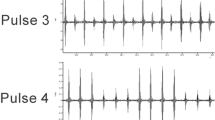Abstract
Females of theDrosophila virilis group of species may vibrate their wings during courtship producing songs consisting of trains of successive sound pulses (pulse song) or sinusoidal hums (sine song). In the present study we describe these songs and study their role in courtship using a transition analysis. To find out which songs should be classified as pulse songs and which ones as sine songs, we studied the inheritance of different song types in interspecific F1 hybrids. In only a few species did the females produce large quantities of song in successful courtships. The males' reactions to female songs varied from licking and singing to stopping the courtship. Pulse trains with short and long intervals between successive pulses appeared to be different forms of the pulse song, while sine song (sinusoidal hums) was inherited independently of the pulse song.
Similar content being viewed by others
References
Bennet-Clark, H. C., Leroy, Y., and Tsacas, L. (1980). Species and sex specific songs and courtship behaviour in the genusZaprionus (Diptera—Drosophilidae)Anim. Behav. 28:230–255.
Bixler, A., Jenkins, J. B., Tompkins, L., and McRobert S. P. (1992). Identification of acoustic stimuli that mediate sexual behavior inDrosophila busckii (Diptera: Drosophilidae).J. Insect Behav. 4:469–478.
Chang, H.-C., and Miller, D. D. (1978). Courtship and mating sounds in the species of theDrosophila affinis subgroup.Evolution 32:540–550.
Cobb, M., Burnet, B., Blizard, R., and Jallon, J.-M. (1989). Courtship inDrosophila sechellia: Its structure, functional aspects, and relationship to those of other members of theDrosophila melanogaster species subgroup.J. Insect Behav. 2:63–89.
Cowling, D. E., and Burnet, B. (1981). Courtship songs and genetic control of their acoustic characteristics in sibling species of theDrosophila melanogaster subgroup.Anim. Behav. 29:924–935.
Crossley, S. A. (1986). Courtship sounds and behaviour in the four species of theDrosophila bipectinata complex.Anim. Behav. 34:1146–1159.
Crossley, S. A. (1990).Drosophila pulse and sine songs and their evolution.Behav. Genet. 20:714 (abstract).
Donegan, J., and Ewing, A. W. (1980). Duetting inDrosophila andZaprionus species.Anim. Behav. 28:1289.
Everitt, B. S. (1977).The Analysis of Contingency Tables, John Wiley, New York.
Ewing, A. W., and Bennet-Clark H. C. (1968). The courtship songs ofDrosophila.Behaviour 31:288–301.
Hoikkala, A. (1985). Evolution of the male courtship sound in the species of theDrosophila virilis group.Acta Univ. Ouluensis A 175 Biol. 25.
Hoikkala, A., and Lumme, J. (1987). The genetic basis of evolution of the male courtship sounds in theDrosophila virilis group.Evolution 41:827–845.
Lakovaara, S. (1969). Malt as a culture medium for Drosophila species.Dros. Info. Serv. 44:128.
Liimatainen, J. (1993). Courtship signals, their importance and inheritance in the species of theDrosophila virilis group.Acta Univ. Ouluensis A 248.
Liimatainen, J., Hoikkala, A., Aspi, J. and Welbergen, Ph. (1992). Courtship inDrosophila montana: The effects of male auditory signals on the behaviour of flies.Anim. Behav. 43:35–48.
Miller, D. D., Goldstein, R. B., and Patty, R. A. (1975). Semispecies ofDrosophila athabasca distinguishable by male courtship sounds.Evolution 29:531–544.
Paillette, M., Ikeda, H., and Jallon, J.-M. (1991). A new acoustic signal of the fruit-fliesDrosophila simulans andD. melanogaster.Bioacoustics 3:247–254.
Sokal, R. R., and Rohlf, F. J. (1981).Biometry, 2nd ed., Freeman, San Francisco.
Suvanto, L., Hoikkala, A., and Liimatainen, J. O. (1994). Secondary courtship songs and inhibitory songs ofDrosophila virilis-group males.Behav. Genet. 24:85–94.
Welbergen, Ph., van Dijken, F. R., and Scharloo, W. (1987). Collation of the courtship behaviour of the sympatric speciesDrosophila melanogaster andD. simulans.Behaviour 101:253–274.
Zar, J. H. (1984).Biostatistic analysis International Editions, Prentice Hall, Englewood Cliffs, NJ.
Author information
Authors and Affiliations
Rights and permissions
About this article
Cite this article
Satokangas, P., Liimatainen, J.O. & Hoikkala, A. Songs produced by the females of theDrosophila virilis group of species. Behav Genet 24, 263–272 (1994). https://doi.org/10.1007/BF01067193
Received:
Accepted:
Issue Date:
DOI: https://doi.org/10.1007/BF01067193




